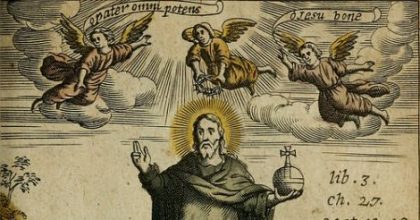
“And that, my lord, is how we know the Earth to be banana-shaped.” “This new learning amazes me, Sir Bedevere. Explain again how sheep’s bladders may be employed to prevent earthquakes.” I couldn’t help but think of that quote from Monty Python and the Holy Grail as I read David Lindberg’s essay on medieval science. Beneath the characteristic Python silliness lies a hint of what actually transpired among western European scholars of the Middle Ages. A New Learning was arriving in the form of classical texts and Arabic treatises, deepening interest and expertise on topics of nature and empirical study. Even if their conclusions were different from ours, the questions they asked and the methods they applied to resolving them should feel familiar.
We’re in the first week of our blog book club on When Science & Christianity Meet and taking a look at chapter 1. The book is a series of case studies looking at significant moments when European & American Christianity conversed with the science of the same cultures. Or more precisely, as the introduction reminds us, when specific individuals who confessed some form of Christian beliefs entered into dialogue with specific individuals studying various scientific disciplines. Sometimes that dialogue was an internal one, as many scientists have themselves been believers. The overall goal is not to support a particular broad conclusion, such as science and religion are fundamentally at odds, or science can only flourish in the context of Abrahamic monotheism. Rather, the authors take an approach that appeals to my fondness for details; they are delving into the specifics to give a flavor for the complexity and diversity that the history of Christian and scientific ideas has to offer.
In Chapter 1, David Lindberg uses Augustine of Hippo and Roger Bacon as examples of how Christian scholars approached science in the period following the decline of Rome but prior to the revolution we typically consider the beginning of modern science. Granted, that’s roughly a millenium so the thoughts and writings of two individuals can scarcely represent the breadth of discourse. But I gather Lindberg is less interested in a survey and more in demonstrating a continuity of ideas between the two men across a significant span of time. Further, Lindberg hints at how those ideas and the conversations around them have carried forward into the present. That’s not to say the discourse has been static all this time, simply that throughlines exist.

 )
)Understanding how ideas have changed and how they have stayed the same can be challenging. Our present way of looking at the world makes so much sense and seems so natural, we can scarcely imagine how it could have been otherwise. Thus we project backwards (and forwards) our current understanding. So it is jarring to reflect on Augustine efforts to explain how the waters of the firmament could exist above a layer of air in an Aristotelian cosmology, given everything we know about atoms, molecules, gravity, etc. At the same time, his discussion of how jars of air behave when submerged in water could easily accompany an interactive exhibit at a present-day science center.
Or consider that mathematical models of the heavens from Augustine’s day could already predict the future positions of stars and planets to a precision comparable to the precision of available observations. Sure, now we have general relativity and a very different mental image of those same heavens, but some of the basic concepts had already been worked out more than 2,000 years ago. But then consider that it was only 100 years ago that we learned about the existence of other galaxies, a fact most grade school students could tell you today.
We’ve discussed previously, and Lindberg mentions at the outset of his essay, the popular notion that the Middle Ages were scientifically backwards. If your standard is accurate descriptions of the world and the causes of various effects, then yes, some medieval science comes up short in ways that can seem just as absurd as a banana-shaped planet. Yet they were interested in making inferences from empirical evidence and using those inferences to make predictions. What sets us apart from our counterparts in antiquity is less the sophistication of our minds or our freedom from dogma and more the accumulated volume of our observations (which may now include images of planets in other galaxies). Collecting and having to reckon with an ever-increasing body of sensory data pushes the development and refinement of new scientific ideas.
Christian theology, on the other hand, doesn’t really get new data, at least in the sense of more scripture from which that theology is derived. Both Augustine and Bacon (and many others) recognized this difference between theology and science and the challenge of understanding both as part of one consistent picture of reality. Their solution was the handmaiden model, wherein science serves the needs of theology and is only worthwhile when it does so. Bacon seems to have taken a wider view of how science could be useful, but its value was still framed by reference to theological pursuits. I think I understand the logic of that approach, but I’m fairly certain it won’t appeal to everyone. So that’s where I’d love to hear from you, about how you would describe your preferred way to connect science and theology. And about whatever else struck you as interesting from this chapter.
Feel free to drop your thoughts in the comments below. And I hope you can join us in two weeks, on February 21 at 7:30pm EST, for a video chat to discuss this chapter and the next two. I’ll be back here next week with my initial reactions to chapter 2 on Galileo.
Andy has worn many hats in his life. He knows this is a dreadfully clichéd notion, but since it is also literally true he uses it anyway. Among his current metaphorical hats: husband of one wife, father of two teenagers, reader of science fiction and science fact, enthusiast of contemporary symphonic music, and chief science officer. Previous metaphorical hats include: comp bio postdoc, molecular biology grad student, InterVarsity chapter president (that one came with a literal hat), music store clerk, house painter, and mosquito trapper. Among his more unique literal hats: British bobby, captain’s hats (of varying levels of authenticity) of several specific vessels, a deerstalker from 221B Baker St, and a railroad engineer’s cap. His monthly Science in Review is drawn from his weekly Science Corner posts — Wednesdays, 8am (Eastern) on the Emerging Scholars Network Blog. His book Faith across the Multiverse is available from Hendrickson.

I was blindsided by the quote, “Every investigation of mankind that is not directed toward salvation is totally blind and leads finally to the darkness of hell,” which was written by Roger Bacon. It has plenty of biblical context (e.g., Mark 8:36), but it still made me think about what I’m doing. Augustine’s warning against “vain curiosity” was also somewhat unsettling to my current understanding of my work. I remember having read that Blaise Pascal in his later years kept something like a tack at his side so that he could jab his finger into it whenever he thought about math as he went about his day so as to keep his thoughts on spiritual things. I had thought that extreme, especially since mathematical objects are exceptionally lovely and pure, and would seem to be particularly encouraged by Philippians 4:8. But, I now wonder if there was wider support at the time for such a discipline. Perhaps the mathematical concepts that intrigued Pascal had no apparent “handmaiden” justification. Or, I think more likely, perhaps there was something about this type of distracted state that Pascal felt was harmful to his spiritual progress. When I think about the theology of work, I usually think about Colossians 3:23, 1 Corinthians 10:31, and similar verses that express the importance of how you do your earthly work (for God’s glory). The only objections I usually hear to categories of earthly work involve some aspect of their inherent sinfulness. Should there be a separate categorization between handmaiden endeavors and vainly curious ones? My impression is that these distinctions would still be based not on the what, but on the how. Augustine regretted his efforts even in logic, geometry, and arithmetic, but I’m sure they no doubt helped him in his thinking. In fact, I remember reading that John Wesley specifically encouraged preachers to study logic and geometry so that they would learn how to think, which would in turn help them understand biblical truth. Augustine’s description of the “vain and curious longing, cloaked under the name of knowledge and learning” being analogous to “that lust of the flesh which lies in the gratification of all senses and pleasures” inclines me to believe he is referring to the same dopaminergic compulsions that make our smartphones, with their endless notifications and novel information, addictive to us in the modern day. So, perhaps, the very same investigations that can be a snare for the mind can also be lovely handmaidens, pursued in thankfulness to God, in His service, and for His glory. I certainly see such a distinction in our use of technology, and I don’t think an extension to the more abstract category of mental endeavors is a stretch. I’m inclined, then, to think that for each practicing scientist, the connection between their investigations and the knowledge of God rests entirely in their hearts. I come away from this meditation convicted with a higher standard for my reading and intellectual endeavors.
That Roger Bacon quote is striking, and also curious to interpret in light of Lindberg’s portrayal of Bacon as fairly liberal about what academic topics were worth of study, at least relative to his peers. Perhaps Bacon had a more expansive view of what is directed towards salvation than might be immediately apparent. If God as revealed through Jesus is simultaneously the Way, the Truth, and the Life, then I think the pursuit of truth wherever it is manifest will be life-giving in some fashion. And the testimony of Scripture overall reveals many ways to love our neighbor. So there would seem to be latitude for a wide range of callings.
I think your observation about dopamine pathways touches on a key consideration. We should always have an eye on our purpose in any pursuit. There is always the possibility to tumble down the rabbit hole of self-obsession. Sometimes some form of discipline is necessary to break out of those neurological positive feedback loops. Perhaps some topics or tasks lead more easily down those pathways, and maybe that depends somewhat on the person, yet with the proper perspective they can be pursued to the glory of God and to serve our neighbors.
I think there is also a related consideration about what is appropriate and necessary for re-creation. Could it be that some pursuits of the mind are too frivolous or self-indulgent for the kind of prolonged reflection typical of academic scholarship, yet also worthwhile in smaller doses as a form of play? That’s obviously outside the scope of the book, but I think still relevant to what it takes to be not only a scholar but a healthy person overall.